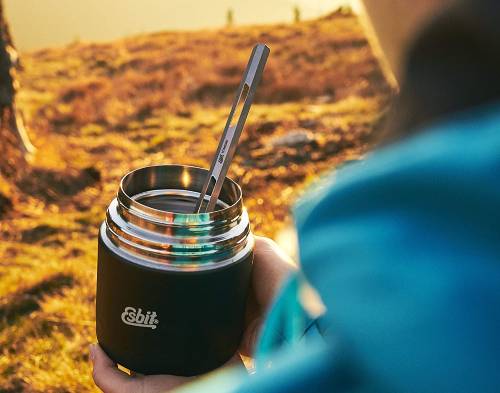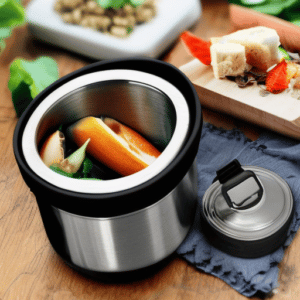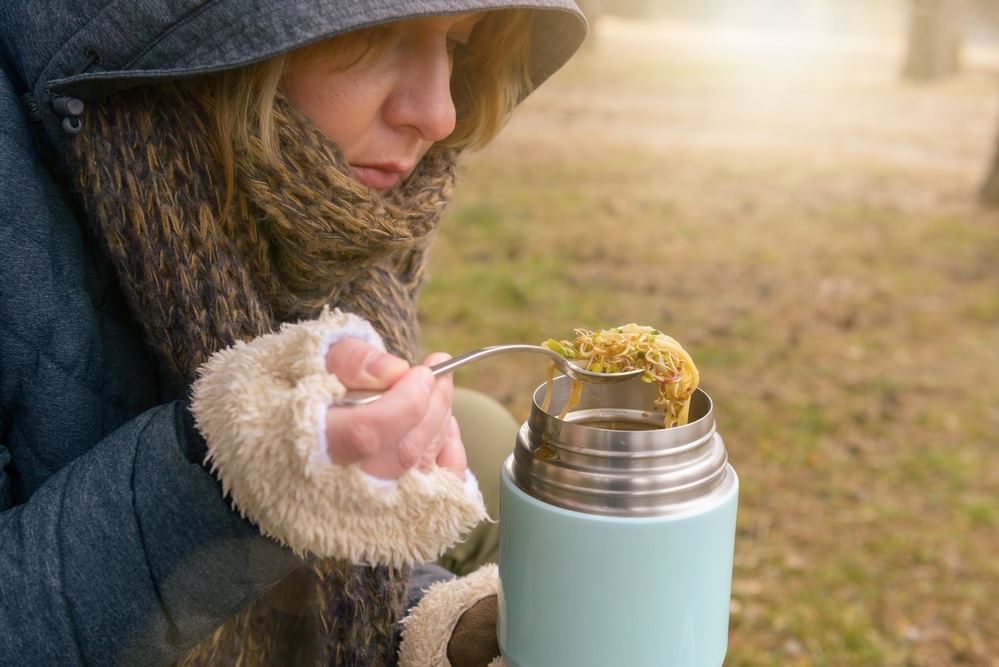There are many advantages to using a thermos, such as keeping lunch hot or cold for your child at school or yourself at work. But how long can you keep your meals warm? This post will go into great detail about this topic and also provide you with some helpful advice.
How to Use a Thermos
If you want to know how to keep food hot in your thermos, you’ll need to preheat the receptacle when it’s time to eat. First, boil water. Then, fill the thermos with boiled water and cover it.
Leave the flask for around five minutes and warm your lunch in the microwave while you’re waiting. Then, pour out the boiling water, place the hot food into the thermos, and seal shut with the lid.

How Long Can You Keep Food Hot in a Flask?
As a general rule of thumb, you can keep food hot in a thermos for up to 5 hours, although some made of lower-quality materials can only heat the food for up to 2 hours. The bigger the thermos, the longer it will stay hot. However, depending on food preparation and the type of meal, you may get varying results when comparing pasta to soups or drinks.
To keep your food above room temperature in the thermos, consider pre-heating the ingredients to a hotter temperature than you ordinarily would consume. You can also keep the thermos extra hot by placing it in a jug of boiling water for several minutes. Make sure to discard any hot water on the exterior and dry the surface before serving the food.
Furthermore, we suggest packing your food in the thermos just before heading out of the door for the day. Doing so will keep your meal or beverages hotter throughout the day.
Boiling water will remain hot for up to six hours in a flask before reducing to a lukewarm temperature.
Look For a Thermos With the Right Design
The thermos’ material and design make a big difference in serving food cold or piping hot. One of the best features of a thermos is using a vacuum seal to prevent any hot air from being lost, thus making your food cold.
In addition, consider a metal thermos, such as stainless steel. This material is a high thermal conductor and keeps food hot or cold, depending on the meal you’ve packed. In addition, fibreglass consists of glass woven together to create a softer fabric. This material is ideal for retaining heat and keeps hot air from escaping.
Is It Safe to Eat Food in a Thermos?

Health and safety are the most important elements of storing food in a hot flask. In particular, make sure that you keep them outside of 4.4 – 60 degrees Celsius. If foods are stored within these temperatures, bacteria can double in as little as 20 minutes.
On the other hand, not all food can create bacteria inside a thermos. However, rice and milk can easily spoil in a thermos lunch tub and may not be safe to eat. Likewise, meats such as chicken and fish spoil much faster than vegetables. Hence, consider eating more nutritious lunches to prevent your food options from entering the danger zone.
There are several tips to consider when checking food safety in thermoses. First, does the food smell unusual? If so, don’t question your nose and bin it. Also, if you think that the meal or drinks have been exposed to the temperatures we mentioned earlier, don’t consider eating it. There are certain foods that you can consume within one hour of being in the danger zone. However, it is not advisable to take the risk.
Ways to Retain Heat in a Hot Food Container at Work
If you want to keep your sushi, coffee, stew, sauce, or soup warm at home or work, ensure that you keep the vacuum flask in a heated area. Even just a little bit of cold air can drop its temperature, making your food way too cold to eat. Keep the hot flask in a thermal lunch bag, so you can enjoy your meal when it’s lunchtime.
Reasons Why Your Vacuum Flask Isn’t Keeping Food Hot
There might be one or more occasions that your thermos isn’t staying hot and doesn’t retain heat. There are several reasons why this might be. First, maybe your thermos doesn’t use a heat-sensitive material, such as stainless steel. Also, always make sure that the lid is securely attached at all times to keep the food heated while you’re busy.
If you’re not sure what the problem is and have exhausted all possibilities, we suggest purchasing a new one with thermal insulation that’s double-walled and vacuum-sealed.
Preventing Food From Going Soggy In a Food Flask
You can store plenty of things in a thermos, but sometimes, the food can go soggy. An example is when you store chicken nuggets inside all day.
You can avoid this issue by placing a paper towel in the food flask. This material will absorb any moisture caused by soggy food. You can then place the food on top of the paper towel to give it the perfect temperature while retaining heat once the lid is on.
Keep Your Food Flask Clean
If you enjoy having a hot dinner at work every day, consider a food flask. However, most options aren’t dishwasher-safe because this can affect the vacuum seal. Therefore, they require rinsing with warm soapy water after each use.
Get into a good habit of emptying your food flask each time you return home from work. Leaving the ingredients sitting in the thermos for hours will increase stains and make it smelly due to the build-up of bacteria. Instead, rinse it thoroughly without immersing it in liquid. Apply a detergent and use a soft cloth to remove any liquid or food marks. If the dish is particularly saucy and might leave some stains, you can fill the thermos with water and leave it to soak for several hours and then rinse clean.
Enjoy a Hot Meal!
Knowing how long you can keep food hot in a flask safely and effectively is important when using a food flask. You wouldn’t want food spoiling when you send your kids to school with some soup.
Overall, a food flask makes a great daily appliance and can make your lunches more exciting. Most can keep meals warm for up to six hours, so you don’t have to use a microwave. Before making your purchase, consider what foods you’ll typically keep in the flask, which will affect the shape you’re looking for.
You can always prepare lunch the night before work to save time, but ensure that you keep your thermos hot by pouring boiling water inside on the day that you need to take it with you. And make sure to pre-heat the food before inserting it into the thermos. Doing so will extend its temperature, so you won’t have to endure a cold meal at work.
Do you have any tips for keeping lunch hot in a thermos? Or perhaps you have some exciting recipes you’d love to share. Either way, let us know your thoughts in the comments.

